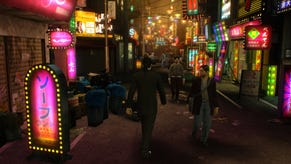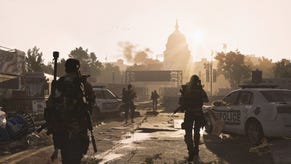The Making of The Division: Underground
From Lego Labyrinths To Digital Dungeons
Beneath The Division’s mighty impressive facsimile of New York lies a continually shifting labyrinth of sewers, subways, secret chambers and the very roots of the city itself: the pipes and machines that keep it ticking. Underground, a new expansion which launched at the tail end of June, is The Division with a procedural twist; a bit of chaos injected into the orderly, crafted world.
The dungeons of Underground sit in a strange place between procedural generation and the curated environments that you’ll find above this subterranean world. They are controlled, but also assorted in random, surprising ways. Ubisoft Reflections recently pulled back the curtain, explaining to me how the sausage is made. And, apparently, it all begins with Lego.
Reflections started production on Underground just after The Division – which they developed several areas and six missions for – shipped. The team had to discover, as technical art director Robert Hexter explains, how to maintain the same quality as the core game, but do it in a procedural way.
“We had to figure out exactly what a dungeon was in Underground. In that short phase of conceptual development there was a lot of high-tech design, prototyping, graph paper, typical game stuff. There were also some code-based prototypes, but the most influential one was Lego. You can’t beat Lego.”
Imagine an assortment of colourful blocks, all stuck on top or beneath each other, cubes and cuboids, going in different directions. That’s a pretty good abstraction of what a dungeon from Underground looks like, when you remove the set dressing and gameplay.
“These Lego blocks are rooms based on atmospheric, impactful environments that we have throughout The Division,” says Hexter. “The rooms are assemblies of many, many different layers of content. The guys generated hundreds and hundreds of rooms, and layered them with gameplay mechanics, loot – all sorts of things are going on inside these rooms. But we don’t use everything that they pile into them. If you were to look at one in our engine, it wouldn’t make any sense to you whatsoever; it’s just a big toy box full of stuff.”
All these toy box rooms and their potential configurations then become part of a list, from which the generation tool can craft a cohesive dungeon with its own narrative, mixture of themes and challenges.
“The core of it is giving the power to the level designers to be able to define a plot,” Hexter says. “What is the essence of the dungeon? How do I provide an experience? So our tooling, at the very first conceptual phase, is a collection of semantics and numbers and possibilities. With that essence, we then add a generator. It’s basically rolling the dice. But rolling that dice is generating a lot of numbers – a lot of numbers that can then go, look through that essence and then look at the source data the creators have actually produced. And then it can assemble that into an experience.”
Dungeons aren’t fleeting things, played once and then consigned to the past. They are deterministic, Hexter explains, and each of them has a seed that can then be put back into the tool and used to generate that exact same dungeon again. This is especially important because it allows the team to test dungeons and rooms, playing it in context. And by making sure all these different components fit in the right way, Reflections is able to hide the seams.
“We have different themes, different environments, so you can’t just stitch a subway rail to a utility room,” Manny Diaz, Underground’s level design director, tells me. “There has to be a logical transition. So we had to create rooms and rules to have a natural transition, and then... the example I used earlier today was: sometimes when you’re transitioning between themes, it can be a long journey, so we needed to figure out a way to have gameplay there, to have engagement, so what we did was add this layer of hazards.”
These hazards, often found in the corridors and stairways between rooms, take the form of environmental obstacles that don’t just exist to be avoided, but to be overcome. It might be exposed electrical cables that will force your team to find a switch, shutting off the juice, before you can get past them. Or it could be an impassable inferno that you’ve got to put out. Look around and maybe you’ll find a water tower to shoot.
“This environment can bite you if you’re not careful.”
Ensuring the warrens of New York feel as seamless and logical as possible is particularly tricky thanks to the flexibility of the rooms. “All of those Lego blocks can actually be spun around,” Hexter notes. “That produces an interesting challenge for the level design team because they have to design levels that work any way around.”
“They have to be flexible in orientation, entry from bottom or top, and they have to be able to support different objective types,” adds Diaz. “So we can have an objective where you’ve got to rescue somebody, and another where you’ve got to destroy part of the infrastructure in the place, or conversely restore some of the infrastructure. And then we have to support layers of set dressing. We can have a room that’s dark and dank on one entry, and you roll the dice and play it later and it’s all on fire. And there are gameplay elements as well. Some will have alarms, same room, another time it will have a skill jammer. So we had to really front load a lot of the consideration of variables.”
I’m walking through a series of derelict corridors, with dripping pipes creating cover and obstacles to clamber over. It’s dark and dreary and every once in awhile my team and I will come across a set of imposing steel doors, fretting about what’s behind them. We’re hunting a fellow with a terrible nickname: Playboy. No doubt a real charmer. I might fight another goon called Playboy in an entirely different location, where he’ll be an entirely different man. I might come across a similar dungeon, but this time all lit up by fire, and my mission will be different. Though the pieces can start to become familiar, their arrangement can offer surprises.
The Division: Underground is unlikely to be the last time we see Ubisoft Reflections playing around with a system like this. It seems to have inspired and energised the team. And no doubt the effort exerted in building it makes it difficult to just put away.
“We took a lot of lessons from The Division,” says Diaz. “Certainly a lot of technological and creative lessons. And Underground has opened our eyes even more to what’s possible, not only with The Division, but at the studio in general. For example, when we reconfigured those rooms, we did not expect some of the outputs. That just opened our eyes and got the wheels turning.”













